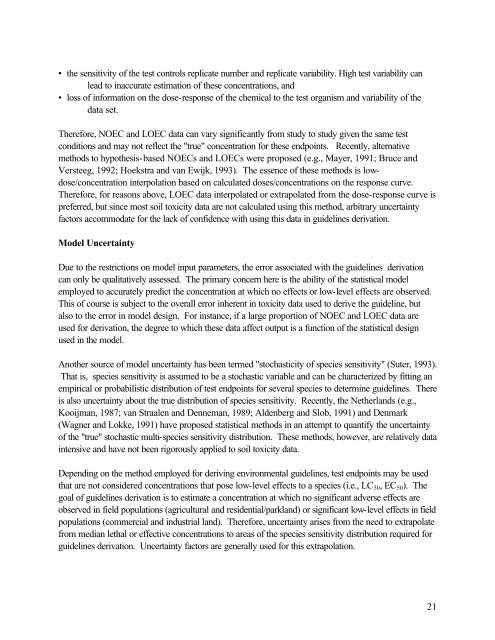Protocol for the Derivation of Environmental and Human ... - CCME
Protocol for the Derivation of Environmental and Human ... - CCME
Protocol for the Derivation of Environmental and Human ... - CCME
Create successful ePaper yourself
Turn your PDF publications into a flip-book with our unique Google optimized e-Paper software.
• <strong>the</strong> sensitivity <strong>of</strong> <strong>the</strong> test controls replicate number <strong>and</strong> replicate variability. High test variability can<br />
lead to inaccurate estimation <strong>of</strong> <strong>the</strong>se concentrations, <strong>and</strong><br />
• loss <strong>of</strong> in<strong>for</strong>mation on <strong>the</strong> dose-response <strong>of</strong> <strong>the</strong> chemical to <strong>the</strong> test organism <strong>and</strong> variability <strong>of</strong> <strong>the</strong><br />
data set.<br />
There<strong>for</strong>e, NOEC <strong>and</strong> LOEC data can vary significantly from study to study given <strong>the</strong> same test<br />
conditions <strong>and</strong> may not reflect <strong>the</strong> "true" concentration <strong>for</strong> <strong>the</strong>se endpoints. Recently, alternative<br />
methods to hypo<strong>the</strong>sis-based NOECs <strong>and</strong> LOECs were proposed (e.g., Mayer, 1991; Bruce <strong>and</strong><br />
Versteeg, 1992; Hoekstra <strong>and</strong> van Ewijk, 1993). The essence <strong>of</strong> <strong>the</strong>se methods is lowdose/concentration<br />
interpolation based on calculated doses/concentrations on <strong>the</strong> response curve.<br />
There<strong>for</strong>e, <strong>for</strong> reasons above, LOEC data interpolated or extrapolated from <strong>the</strong> dose-response curve is<br />
preferred, but since most soil toxicity data are not calculated using this method, arbitrary uncertainty<br />
factors accommodate <strong>for</strong> <strong>the</strong> lack <strong>of</strong> confidence with using this data in guidelines derivation.<br />
Model Uncertainty<br />
Due to <strong>the</strong> restrictions on model input parameters, <strong>the</strong> error associated with <strong>the</strong> guidelines derivation<br />
can only be qualitatively assessed. The primary concern here is <strong>the</strong> ability <strong>of</strong> <strong>the</strong> statistical model<br />
employed to accurately predict <strong>the</strong> concentration at which no effects or low-level effects are observed.<br />
This <strong>of</strong> course is subject to <strong>the</strong> overall error inherent in toxicity data used to derive <strong>the</strong> guideline, but<br />
also to <strong>the</strong> error in model design. For instance, if a large proportion <strong>of</strong> NOEC <strong>and</strong> LOEC data are<br />
used <strong>for</strong> derivation, <strong>the</strong> degree to which <strong>the</strong>se data affect output is a function <strong>of</strong> <strong>the</strong> statistical design<br />
used in <strong>the</strong> model.<br />
Ano<strong>the</strong>r source <strong>of</strong> model uncertainty has been termed "stochasticity <strong>of</strong> species sensitivity" (Suter, 1993).<br />
That is, species sensitivity is assumed to be a stochastic variable <strong>and</strong> can be characterized by fitting an<br />
empirical or probabilistic distribution <strong>of</strong> test endpoints <strong>for</strong> several species to determine guidelines. There<br />
is also uncertainty about <strong>the</strong> true distribution <strong>of</strong> species sensitivity. Recently, <strong>the</strong> Ne<strong>the</strong>rl<strong>and</strong>s (e.g.,<br />
Kooijman, 1987; van Straalen <strong>and</strong> Denneman, 1989; Aldenberg <strong>and</strong> Slob, 1991) <strong>and</strong> Denmark<br />
(Wagner <strong>and</strong> Lokke, 1991) have proposed statistical methods in an attempt to quantify <strong>the</strong> uncertainty<br />
<strong>of</strong> <strong>the</strong> "true" stochastic multi-species sensitivity distribution. These methods, however, are relatively data<br />
intensive <strong>and</strong> have not been rigorously applied to soil toxicity data.<br />
Depending on <strong>the</strong> method employed <strong>for</strong> deriving environmental guidelines, test endpoints may be used<br />
that are not considered concentrations that pose low-level effects to a species (i.e., LC 50 , EC 50 ). The<br />
goal <strong>of</strong> guidelines derivation is to estimate a concentration at which no significant adverse effects are<br />
observed in field populations (agricultural <strong>and</strong> residential/parkl<strong>and</strong>) or significant low-level effects in field<br />
populations (commercial <strong>and</strong> industrial l<strong>and</strong>). There<strong>for</strong>e, uncertainty arises from <strong>the</strong> need to extrapolate<br />
from median lethal or effective concentrations to areas <strong>of</strong> <strong>the</strong> species sensitivity distribution required <strong>for</strong><br />
guidelines derivation. Uncertainty factors are generally used <strong>for</strong> this extrapolation.<br />
21
















